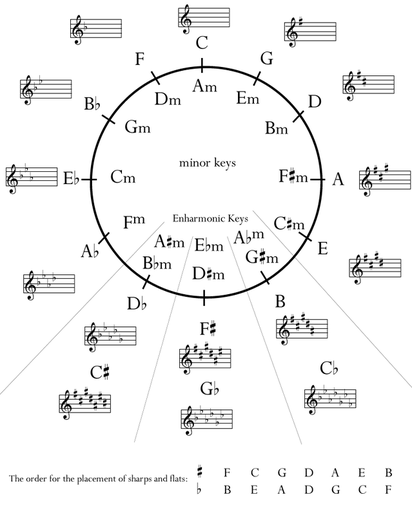Major and Minor Key Signatures and Identification

Q. How do I know if I am using a major or a minor key?
A. Generally you observe the starting and ending notes (and sometimes the entire chords). These will generally indicate the type of tonality (major or minor) being used.
Major Key Signatures
Minor Key Signatures
A. Generally you observe the starting and ending notes (and sometimes the entire chords). These will generally indicate the type of tonality (major or minor) being used.
Major Key Signatures
- If you begin on C and play up or down the scale and don't play any "black keys," you have a major scale.
- Here is how you identify which major scale you are using according to the key signature:
- No sharps or flats in the key signature is C-Major.
- One flat in the key signature is F-Major.
- One sharp in the key signature is G-Major.
- If there are two or more flats, identify the penultimate flat (second to the last flat) and that is the key. For example, if there are three flats, they are B-flat, E-flat and A-flat. The second to the last flat is E-flat. This is the key of Eb-Major.
- If there are two or more sharps, identify the last sharp. Move up one step (to the next space or line) and that is the key. For example, if there are four sharps, they are F-sharp, C-sharp, G-sharp, D-sharp. One step above the D-sharp is E. This is the key of E-Major.
Minor Key Signatures
- Each major key has a relative natural minor key. That is, a minor key which has the same number of sharps or flats as the major key.
- For example, A-Minor has the same key signature as C-Major. If you don't play any of the "black keys" and start on A (instead of C) you will play a natural A-minor.
- From a key signature, identify the Major key. If the beginning note(s) and/or ending note(s) and/or chord(s) are minor or start three half-steps below the major keynote, you are probably in a minor key.
- Read down three piano "half-steps" from the major key. This is the relative minor key.
- For example, if I know that the song is in a minor key and the key signature indicates F-Major, I count down three piano half-steps (from F to E, from E to Eb, from Eb to D) and find the piece in D-Minor.
- D-Minor and F-Major have the same key signature.
